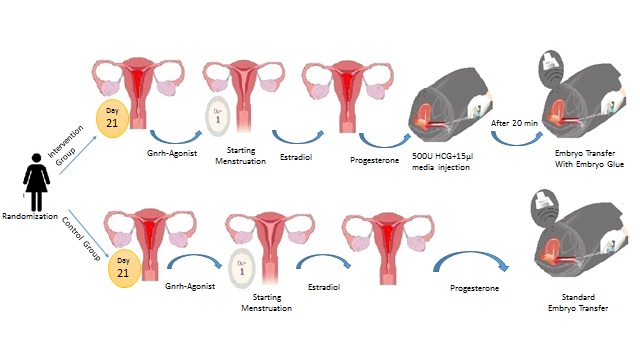Wed, Nov 5, 2025
[Archive]
Volume 23, Issue 9 (September 2025)
IJRM 2025, 23(9): 701-712 |
Back to browse issues page
Ethics code: IR.MAZUMS.IMAMHOSPITAL.REC.1401.038
Download citation:
BibTeX | RIS | EndNote | Medlars | ProCite | Reference Manager | RefWorks
Send citation to:



BibTeX | RIS | EndNote | Medlars | ProCite | Reference Manager | RefWorks
Send citation to:
Peivandi S, Jafarifard P, Zamaniyan M, Yazdani-charati J. Impact of intrauterine infusion of human chorionic gonadotropin and hyaluronic acid enriched medium on pregnancy outcomes infrozen-thawed cycles with recurrent implantation failure: An RCT. IJRM 2025; 23 (9) :701-712
URL: http://ijrm.ir/article-1-3428-en.html
URL: http://ijrm.ir/article-1-3428-en.html
1- Department of Obstetrics and Gynecology, IVF Ward, Faculty of Medicine, Sexual and Reproductive Health Research Center, Imam Khomeini Hospital, Mazandaran University of Medical Sciences, Sari, Iran. , dr_peyvandi@yahoo.com; speivandi@mazums.ac.ir
2- Department of Obstetrics and Gynecology, Faculty of Medicine, Imam Khomeini Hospital, Mazandaran University of Medical Sciences, Sari, Iran.
3- Department of Obstetrics and Gynecology, IVF Ward, Faculty of Medicine, Sexual and Reproductive Health Research Center, Imam Khomeini Hospital, Mazandaran University of Medical Sciences, Sari, Iran. & Diabetes Research Center, Imam Khomeini Hospital, Mazandaran University of Medical Sciences, Sari, Iran.
4- Department of Biostatistics, Faculty of Health, Imam Khomeini Hospital, Mazandaran University of Medical Sciences, Sari, Iran.
2- Department of Obstetrics and Gynecology, Faculty of Medicine, Imam Khomeini Hospital, Mazandaran University of Medical Sciences, Sari, Iran.
3- Department of Obstetrics and Gynecology, IVF Ward, Faculty of Medicine, Sexual and Reproductive Health Research Center, Imam Khomeini Hospital, Mazandaran University of Medical Sciences, Sari, Iran. & Diabetes Research Center, Imam Khomeini Hospital, Mazandaran University of Medical Sciences, Sari, Iran.
4- Department of Biostatistics, Faculty of Health, Imam Khomeini Hospital, Mazandaran University of Medical Sciences, Sari, Iran.
Abstract: (72 Views)
Background: Recurrent implantation failure in assisted reproductive technology is a major challenge. Intrauterine human chorionic gonadotropin (hCG) infusion and hyaluronic acid enriched embryo transfer media have shown individual effects, but their combined effect in these cases undergoing frozen-thawed embryo transfer is unknown.
Objective: This study aims to investigate the effect of combined therapy on pregnancy outcomes.
Materials and Methods: This is a single-blind, randomized controlled trial on 158 participants. The cases were randomly assigned to either the intervention group (pretransfer intrauterine hCG infusion and embryo loaded with hyaluronic acid-enriched embryo transfer medium at the time of transfer) or the control group (standard embryo transfer medium). The outcomes were chemical and clinical pregnancy rates, implantation, abortion, and ongoing pregnancy rates.
Results: A total of 158 participants were enrolled in this study in 2 equal groups. The intervention did not significantly improve the overall pregnancy rate compared to control (24% vs. 33.7%, p = 0.30). The results showed that, by controlling variables, the chance of clinical pregnancy in the intervention group was 12% lower than in the control group, although the difference was not statistically significant (p = 0.879). With each increase in the number of embryos, the chance of a pregnancy would be 2.26 times higher. Also, the chance of pregnancy in the morula stage was 68% lower than in the cleavage stage (p < 0.05).
Conclusion: The combined approach of intrauterine hCG infusion and the hyaluronan-enriched embryo transfer medium did not significantly improve the overall pregnancy rate but had a significant effect on specific cases using the embryo at the cleavage stage for transfer and cases that received more than one embryo for transfer.
Objective: This study aims to investigate the effect of combined therapy on pregnancy outcomes.
Materials and Methods: This is a single-blind, randomized controlled trial on 158 participants. The cases were randomly assigned to either the intervention group (pretransfer intrauterine hCG infusion and embryo loaded with hyaluronic acid-enriched embryo transfer medium at the time of transfer) or the control group (standard embryo transfer medium). The outcomes were chemical and clinical pregnancy rates, implantation, abortion, and ongoing pregnancy rates.
Results: A total of 158 participants were enrolled in this study in 2 equal groups. The intervention did not significantly improve the overall pregnancy rate compared to control (24% vs. 33.7%, p = 0.30). The results showed that, by controlling variables, the chance of clinical pregnancy in the intervention group was 12% lower than in the control group, although the difference was not statistically significant (p = 0.879). With each increase in the number of embryos, the chance of a pregnancy would be 2.26 times higher. Also, the chance of pregnancy in the morula stage was 68% lower than in the cleavage stage (p < 0.05).
Conclusion: The combined approach of intrauterine hCG infusion and the hyaluronan-enriched embryo transfer medium did not significantly improve the overall pregnancy rate but had a significant effect on specific cases using the embryo at the cleavage stage for transfer and cases that received more than one embryo for transfer.
Keywords: Embryo transfer, Hyaluronic acid, Chorionic gonadotropin, Embryo implantation, Pregnancy outcome.
Type of Study: Original Article |
Subject:
Fertility & Infertility
Send email to the article author
| Rights and permissions | |
 |
This work is licensed under a Creative Commons Attribution-NonCommercial 4.0 International License. |








